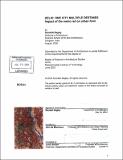| dc.contributor.advisor | John de Monchaux. | en_US |
| dc.contributor.author | Bagley, Saurabh, 1978- | en_US |
| dc.contributor.other | Massachusetts Institute of Technology. Dept. of Architecture. | en_US |
| dc.coverage.spatial | a-ii--- | en_US |
| dc.date.accessioned | 2011-06-20T15:51:27Z | |
| dc.date.available | 2011-06-20T15:51:27Z | |
| dc.date.copyright | 2003 | en_US |
| dc.date.issued | 2003 | en_US |
| dc.identifier.uri | http://hdl.handle.net/1721.1/64562 | |
| dc.description | Thesis (S.M.)--Massachusetts Institute of Technology, Dept. of Architecture, 2003. | en_US |
| dc.description | Includes bibliographical references (p. 144-145). | en_US |
| dc.description.abstract | Cities grow and with it urban form, unique to each, keeps evolving. Delhi can be perceived as having a poly centric, poly-nodal, radial city structure and a circumferential and partly sectoral form. World over, cities have evolved from a complex relationship between numerous influencing factors. It can be argued that in present times, transport and technology are the two significant pre-cursors of change. The next decade in India is going to see massive interventions in urban areas with regard to infrastructure, especially those related to transportation. The city of Delhi is an appropriate case to examine in this regard as currently a mass rapid transport system is being introduced in the city. Delhi is a unique city as it is probably the only capital city in the world both in terms of its physical size and population it serves that relies only on buses for public transport. It is also a city which has grown rapidly post independence failing any formal planning interventions proposed by the subsequent master plans for its containment. The introduction of the new transit system being one of the biggest financial investments in the city post independence is seen as an opportunity to restructure the city to accommodate an increase in population of 10 million people and also to define future urbanization trends in the region. This thesis is an inquiry aimed at understanding as to how the advent of mass transit can be utilized by a city like Delhi to limit its sprawl and address changes in land use patterns. A comparative study of other world city regions encourages one to think that intensifying development along transit corridors and at nodes is one option which could lead to a more efficient distribution of people in the city of Delhi. The thesis also questions the nature of present planning framework for the city and suggests appropriate planning and policy adjustments to complement the pattern of development proposed in context with the opportunities presented by the advent of the new mass transit system. | en_US |
| dc.description.statementofresponsibility | by Saurabh Bagley. | en_US |
| dc.format.extent | 145 p. | en_US |
| dc.language.iso | eng | en_US |
| dc.publisher | Massachusetts Institute of Technology | en_US |
| dc.rights | M.I.T. theses are protected by
copyright. They may be viewed from this source for any purpose, but
reproduction or distribution in any format is prohibited without written
permission. See provided URL for inquiries about permission. | en_US |
| dc.rights.uri | http://dspace.mit.edu/handle/1721.1/7582 | en_US |
| dc.subject | Architecture. | en_US |
| dc.title | Delhi-- one city multiple destinies : impact of the metro rail on urban form | en_US |
| dc.type | Thesis | en_US |
| dc.description.degree | S.M. | en_US |
| dc.contributor.department | Massachusetts Institute of Technology. Department of Architecture | |
| dc.identifier.oclc | 53283578 | en_US |
